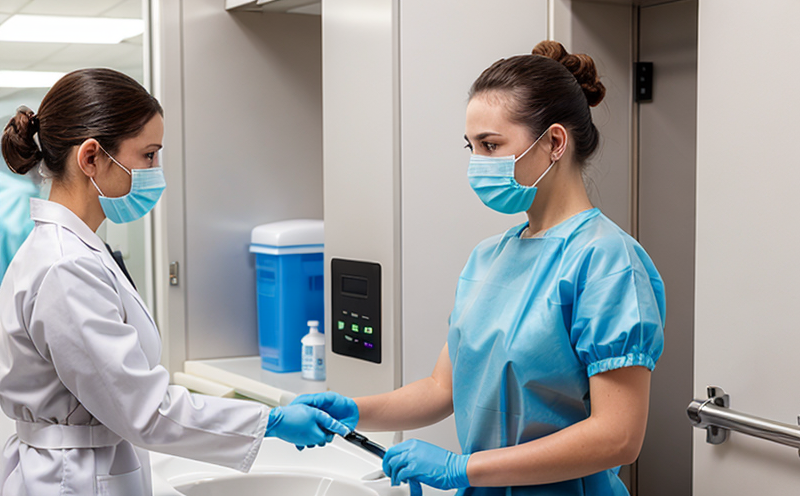AATCC 30 Antifungal activity of textile materials
The AATCC Test Method 30 is a standard procedure designed to measure the antifungal activity of textiles. This method evaluates how effectively a textile material inhibits fungal growth, which is crucial for ensuring products meet hygienic standards and consumer expectations.
Textile materials come into contact with various microorganisms in everyday use, including fungi such as Candida albicans, Aspergillus niger, and Fusarium solani. These fungi can thrive on textiles, leading to potential health risks. By using the AATCC 30 method, manufacturers can ensure that their products maintain hygienic properties over time.
The test involves placing a sample of textile material into a medium containing a fungal inoculum and incubating it under controlled conditions. The antifungal activity is then measured by quantifying the inhibition zone around the sample or by determining the percentage reduction in fungal growth compared to control samples without any treatment.
Proper specimen preparation is critical for accurate testing results. Samples must be cut into standardized dimensions, typically 5 cm x 5 cm pieces, and should represent the material's intended use and finish. Preparing specimens with consistent dimensions ensures that variations due to size or shape do not affect the test outcome.
Instrumentation used in this method includes incubators for maintaining controlled temperature and humidity conditions during the test period. Additionally, microscopes equipped with appropriate objectives may be necessary for examining fungal growth patterns around treated and untreated samples.
The acceptance criteria for AATCC 30 specify that a minimum inhibition zone of at least 15 mm must be achieved for the textile sample to pass the test. This threshold ensures that significant antifungal activity has been demonstrated, providing consumers with confidence in the product's hygiene performance.
Understanding the significance of this standard helps quality managers and compliance officers appreciate its role in safeguarding public health. For R&D engineers, familiarity with AATCC 30 provides valuable insights into developing innovative products that meet stringent hygienic requirements.
Quality and Reliability Assurance
The implementation of the AATCC Test Method 30 plays a vital role in maintaining quality and reliability across various sectors. Textile manufacturers, especially those producing healthcare textiles like hospital gowns or athletic wear designed for high-intensity use, benefit significantly from this standard.
Quality assurance teams rely on consistent application of such tests to ensure that every batch produced meets the specified hygienic standards. By adhering to AATCC 30 guidelines, these organizations can minimize risks associated with microbial contamination, thereby protecting both end-users and themselves against potential liability issues.
In terms of reliability assurance, regular verification through independent laboratories ensures continuous compliance with industry norms. This not only builds trust among customers but also enhances brand reputation as a leader in producing hygienically sound products.
For procurement departments involved in sourcing raw materials or finished goods for use within their operations, ensuring compliance to AATCC 30 adds another layer of reassurance that the purchased items will perform as expected under real-world conditions. This proactive approach helps prevent costly rejections later down the supply chain and streamlines integration into existing processes.
Competitive Advantage and Market Impact
Incorporating AATCC 30 into product development strategies offers significant competitive advantages in today's market. Consumers are increasingly aware of the importance of hygiene and are more likely to choose products that have undergone rigorous testing.
Companies that demonstrate leadership by incorporating advanced hygienic features like antimicrobial properties into their offerings can differentiate themselves from competitors who do not offer similar protections against microbial contamination. This differentiation translates directly into increased market share as consumers prioritize safety and quality when making purchasing decisions.
AATCC 30 compliance also opens up new opportunities for entering niche markets focused specifically on health-related textiles or performance garments designed for extreme conditions where hygiene is paramount. These specialized segments often command premium pricing due to the perceived added value they provide.
Moreover, maintaining consistent adherence to this standard fosters long-term relationships with stakeholders including suppliers, customers, and regulatory bodies. It establishes credibility and demonstrates commitment to ethical business practices, which are increasingly valued by all parties involved in textile manufacturing and distribution.
Use Cases and Application Examples
| Use Case | Description |
|---|---|
| Hospital Linens | Ensuring that hospital linens maintain their hygienic properties over time is critical for preventing cross-infections. The AATCC 30 method helps manufacturers verify the effectiveness of treatments applied to these textiles. |
| Athletic Wear | Performance garments often require exceptional durability and comfort while minimizing odor issues caused by microbial activity. Testing with AATCC 30 ensures that the materials used in athletic wear remain hygienic even after repeated washings. |
| Patient Gowns | Hygiene is a top priority when it comes to patient gowns, especially for those dealing with compromised immune systems. AATCC 30 compliance guarantees that these garments do not harbor harmful fungi during use. |
| Caregiver Clothing | For caregivers working in healthcare settings where they may come into contact with various types of pathogens, ensuring the hygienic integrity of their clothing is essential. This method helps verify that such garments maintain their effectiveness over prolonged usage. |
The AATCC Test Method 30 has wide-ranging applications across numerous industries beyond just healthcare textiles and athletic wear. Its relevance extends to any sector where maintaining hygiene and preventing microbial contamination is crucial, including but not limited to upholstery, automotive interiors, and personal care products.





